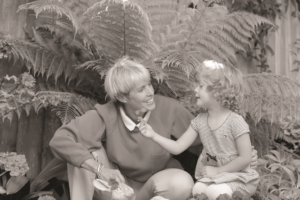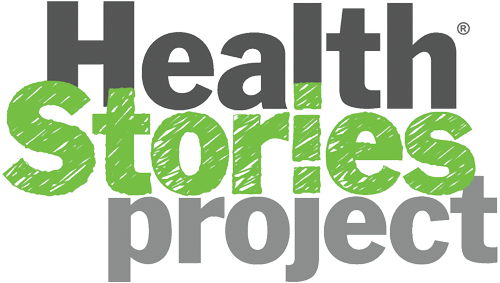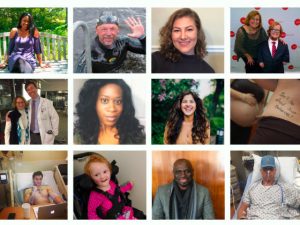The day Patsy Schuchardt noticed that every car in the parking lot had a flat tire, she knew something was wrong. Not with the tires – they were actually fine – but with her sight.
A few months earlier, Patsy had noticed her vision starting to slip. She’d been talking with a painter about trim on her house, and when she looked up at the trim, it wasn’t a straight line. “It was all wavy,” Patsy recalls.



“He said he’d never seen it happen so fast,” Patsy recalls.
At the clinic, they did a test called fluorescein angiography where they injected fluorescein dye in her arm in order to take photographs of the eye as the dye passed through the retinal blood vessels. It took a few days to confirm Patsy’s diagnosis: age-related macular degeneration (AMD).
So what is AMD?
AMD is the leading cause of vision loss among people in the United States. It occurs when the central portion of the retina, called the macula, deteriorates. This affects vision – and by extension, the ability to see and recognize objects or people and do common, self-sufficient tasks such as reading or driving.
In Patsy’s case, her doctor diagnosed two types of AMD: “wet” AMD in her right eye and “dry” AMD in her left eye. The dry form is the most common type of AMD, characterized by thinning of the layers in the macula. Wet AMD occurs when blood vessels leak fluids, lipids, and blood into the macular layers of the retina, causing scar tissue to form and retinal cells to stop functioning.
Risk for developing macular degeneration increases after age 55, with genetics, environment, and lifestyle also playing a role. Patsy’s own risk factors included age – she was 62 when she was diagnosed – and heredity: her mother had macular degeneration and also glaucoma, another eye condition.
Getting Treatment
At the initial time of her diagnosis, Patsy says there weren’t a lot of treatment options for AMD. Blindness was not an immediate cause for concern: “My vision was OK – it was wavy, but it was OK.”
Patsy participated in clinical trials for treatments such as Lucentis (ranibizumab injection), in which shots are administered to block the production of a chemical called vascular endothelial growth factor, or VEGF and thereby slowing the growth of the blood vessels that leak into the eye. The treatments were effective for the right eye with wet AMD, but may have caused the cataract that developed in that eye. Now Patsy wears a contact lens to improve her long-distance vision in the right eye. The Lucentis shots are not an option for dry AMD, so Patsy’s left eye is “pretty useless,” according to her.
Patsy speaks warmly of her physicians at UCSF Ophthalmology, Dr. Brooks Crawford and Dr. Jacque Duncan, and credits them not only for their medical expertise but also for the care and encouragement they give.
“I think I’d be the worst blind person in the world, but Jacque tells me, ‘no, you’d be fine – you’d be amazed at how well people can adjust to losing vision.'”
Adjusting to Life with AMD
Patsy’s lifestyle has always been vibrant and active, and she has not let macular degeneration slow her down. A self-described outdoor person, her regular activities at her current age of 74 might leave others breathless: golf, running, mountain biking, and spending time with her grandchildren.
But she has made some adjustments to her lifestyle because of macular degeneration.
- Driving: With 20/40 vision in one eye, she is still able to drive; however, she has to pass a test every year. “I don’t want to be dangerous to anybody, including myself, so I make sure to get tested.” She also avoids driving at night.
- Physical activity: She switched from tennis to golf: “If my ball goes way up in the air, my friends just tell me where it went.” She also started doing yoga, something that she was initially reluctant about: “I didn’t think I was a meditation kind of girl.” She credits her yoga instructor for helping her learn how to get through difficult moments with breathing and stretching.
- Reading technology: Audiobooks do not interest her, so she has opted for a Kindle Paperwhite device: “It’s backlit which is the best thing for me. Even so, some days I can read it, some days I can’t.”
[tweet_box design=”default”]”It’s ok to cry at the diagnosis but then you have to get on with your life and realize all the good things that you have.” – Patsy, #AMD[/tweet_box]
Embarrassment, Uncertainty, and Accepting Help
In addition to affecting daily life, AMD has an emotional impact, too.
Patsy often has trouble recognizing people she knows until they are very nearby. Her friends sometimes try to make light of it when Patsy tells them she has an eye condition. “They say ‘oh good, then you won’t see my wrinkles,'” she recalls. “Give me a break.”
Patsy adores her grandchildren and finds it hard that she can’t see well when attending important events like her granddaughter’s musical performances or her grandson’s basketball games. “I see a person running up and down the court when someone points him out, but I can’t see him.”
As she loses more eyesight, she also faces the fear of being less independent and self-sufficient. “My husband had to pick me up at the hospital the other day. I told him I’d take a cab, but he wanted to pick me up,” she recalls.
“Sometimes that’s the hard part – letting people help when they want to.”
A Chance to Help Lead the Way
Patsy has channeled her can-do attitude into helping others affected by eye conditions. For nearly 10 years, she has served on the Board of Directors for That Man May See, a nonprofit foundation which supports the vision of UCSF Ophthalmology: to save and restore sight for present and future generations. Patsy helps to raise funding for vision research at UCSF, thus giving back to the medical researchers and clinicians who have done so much for her.
Picking Yourself Up
Patsy admits that when she initially learned about AMD, it was scary. She spent the day in tears after first getting the diagnosis.
“I thought I’d get cancer, break a leg, something, but I never thought I’d go blind. I had perfect vision – I could read street signs from a mile away. Then all of a sudden I couldn’t.”
But Patsy has faced other devastations in the past and learned to move ahead. Her first husband died in a plane crash, leaving her with a 4-year-old daughter to raise. Despite initially feeling like it “was the end of the world,” Patsy developed a new capacity for endurance and survival. “I said, ‘You can give in, or you can be a mother to your daughter.'” Patsy did just that, later remarrying and adopting a son.
This spirit to survive and thrive has served Patsy well and it’s the hallmark of her outlook on her active, full life. For others who are dealing with AMD, Patsy offers up these reflections based on her experience:
- Take care of yourself. Lifestyle factors such as healthy eating, exercise, and not smoking can reduce risk for AMD and possibly slow its progression.
- Get a support system. “Try to keep a good group of friends and find good doctors.” Patsy’s key support team includes her husband, her adult children, and her doctors.
- Get involved. “Get involved — as I did with That Man May See and the amazing doctors at UCSF.”
- Don’t give up. “Don’t let a diagnosis of macular degeneration get you down.”
“It’s ok to cry at the diagnosis but then you have to get on with your life and realize all the good things that you have.”
Have you been affected by Age-related Macular Degeneration (AMD)? Sign up to share your experiences with Health Stories Project!


I have retinal vein thrombosis in one eye, wet macular degeneration in other eye. I get Avastin injections in both eyes every 5 weeks.
Wet or dry, I don’t know. It must be a little over a year since I was told I was beginning the condition. I knew it would come as it has been on my paternal line for four generations, at least. My doctor has said, “You will never be as blind as your father, we will keep it from getting that bad.” My father and his brother and two sisters all blind before death.
Patch s is me 100% incl the golf playing …all symptoms she has I have so not much to add…I lift weights…golf 2x per week….had to stop playing basketball with 40 yr olds which I miss very much…depth perception shooting at basket…wet in rt eye…dry left…rt eye shot every 17 weeks for about 3 years…dr says all going well…yrs take areds2 every day…at 83 my 40 yr old friends think I’m Superman….welll very blessed so far but this and is scary…hoping for some medical advancement since my living years are coming to a close..ty for listening…
I also have wet macular degeneration in my right eye. It came on very suddenly about three years ago. I visited my eye doctor in the month of August for a regular checkup. He said my eyes were good. They were 20/30. From August to October, same year I noticed things were becoming blurry. I set up an appointment and went to see my eye doctor again. Upon examining my eyes he stated to me that I had a hole in my right eye and recommended that I see an eye specialist. Since then I have been receiving eye injections every three months and taking vitamins twice a day. I guess my question is how can this occur in such a short span of time, two months.
The information is useful and encouraging.
I was diagnosed with dry amd about a year and a half ago and now they say it is in advanced stage have to go back in six months to have rechecked. does dry usually turn to wet my dr said it probably would turn to wet